zusammen wachsen, 2023
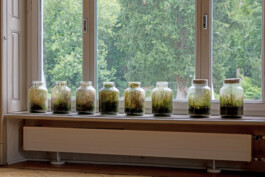
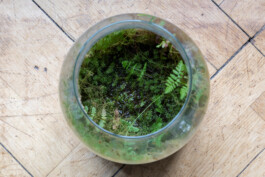

zusammen wachsen, 2023, Museum Morsbroich, Leverkusen; Photo: Werner Hannappel
zusammen wachsen, 2023, Museum Morsbroich, Leverkusen; Photo: Werner Hannappel
zusammen wachsen, 2023, Museum Morsbroich, Leverkusen; Photo: Werner Hannappel
When the Morsbroich Workshop was founded in 2022 to rethink the museum and redesign the Morsbroich ensemble, it was necessary to clarify how each member would approach their area of responsibility and how the workshop as a collective would tackle the challenge. Collaborations quickly formed within the workshop. It was clear that in this structure of individuals and fields of activity, tasks could not be solved alone, but rather through dialogue.
Gabriela Oberkofler captured the dynamics of the early phase of the workshop process with her moss work. She invited the artists of the workshop to bring moss from their hometowns or elsewhere. Gabriela placed two or three different types of moss in a jar, which has remained sealed ever since (!). Each jar functions as a self-contained ecosystem in which the moss absorbs water in a cycle, extracts nutrients from it, and releases the liquid again. The mosses grow in the jars, they mate and crossbreed. As in an experiment, new, previously unknown species emerge.
The growth of moss can thus be seen as a symbol of the work of the artist collective, a work of constant transformation, cooperation, and renewal. Gabriela compares the way moss communicates directly with its environment, absorbing and releasing water, to the work of a museum: “What moss does with water, the museum does with social issues. It absorbs them and releases them in transformed form in the form of exhibitions.”
For the presentation of the moss glasses in the former ladies' salon and garden room of Morsbroich Castle, Gabriela, in cooperation with Harald F. Müller (Werkstatt Morsbroich), has planned a colorful frame with a slightly shimmering shade of pink (“Chanel”) developed by him and coordinated with the Rococo decoration.
Schwebende Tafel Morsbroich, 2023
Temporary installation in the Garden Hall of Morsbroich Castle
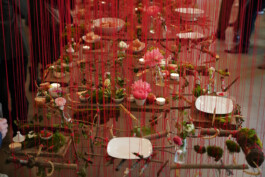
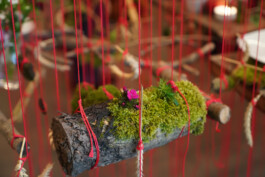
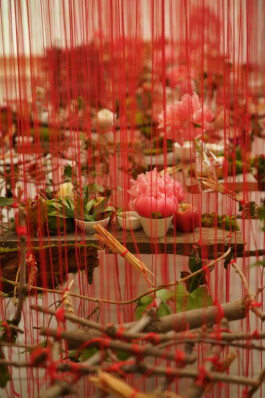
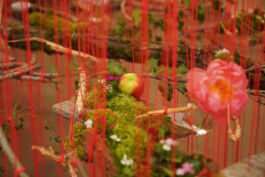

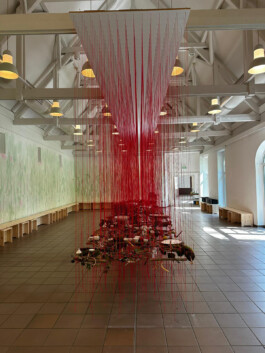
Schwebende Tafel Morsbroich, 2023, temporary installation in the Garden Hall of Morsbroich Castle; Poto: Werner Hannappel
Schwebende Tafel Morsbroich, 2023, temporary installation in the Garden Hall of Morsbroich Castle; Poto: Werner Hannappel
Schwebende Tafel Morsbroich, 2023, temporary installation in the Garden Hall of Morsbroich Castle; Poto: Werner Hannappel
Schwebende Tafel Morsbroich, 2023, temporary installation in the Garden Hall of Morsbroich Castle; Poto: Werner Hannappel
Schwebende Tafel Morsbroich, 2023, temporary installation in the Garden Hall of Morsbroich Castle; Poto: Jochen Maier
Schwebende Tafel Morsbroich, 2023, temporary installation in the Garden Hall of Morsbroich Castle; Poto: Jochen Maier
On the occasion of the Morsbroich Art Days in May 2023, an invitation was issued for the “Morsbroich Banquet” on Saturday evening. A “celebratory evening” would be celebrated at a floating table. “Eating, drinking, listening, and talking” were to become a “sensory total experience under the conditions of art.” For one weekend at least, art would take over the restaurant rooms and the garden hall in the northern coach houses, the former barns of Morsbroich Castle, which had been empty for some time, and turn them into stages. They were used by the members of the Morsbroich Workshop as hosts and, last but not least, by the guests themselves.
The preparation and presentation of the banquet in four courses tailored to the offerings of the Morsbroich orchard were directed by Antje Schiffers. For Sunday, the volunteers from the museum shop arranged a “floating cake buffet” with a large selection of homemade baked goods. The special artistic staging of the banquet hall was entirely in the hands of Gabriela Oberkofler, whose installation ensured an unforgettable experience.
A floating table suspended from the ceiling, composed of a wealth of enticing individual pieces: the image Gabriela created is vaguely reminiscent of the lavishly laid tables of the courtly Baroque era with their rich decorations. However, she immediately dispels this impression by transforming the table into a state of mobility and fragility. There is no longer a fixed, hierarchically ordered seating arrangement. Instead, the table is accessible to everyone and from all sides—just as the castle has opened itself up as a museum for society, which now gathers here as a table society and allows the table around which people move to become a place of encounter.
She hung hundreds of red strings from the ceiling and designed the garden hall like a spatial drawing, with densely placed vertical hatching in the center of the room and largely abstract painting on the back walls, which could be read as a landscape with its green and pink tones, a counterpart to the window views of the castle garden opposite. What came together at table height to form a multi-part, visually overwhelming yet fragile table that swayed delicately when handled were all small wonders of nature: moss-covered branches, (serving) boards made of old wood, leaf tendrils, flowers, ears of corn, and fruits. However, the fact that this brilliant image of nature, in all its lightness and opulence, literally hung by a thread also made it a metaphor for vulnerability. As the food was served course by course, it gave the impression that nature itself was offering the feast—a gift that one was invited to accept with a different awareness.
Eingefleischte Wege, 2023–2025
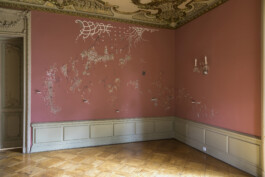

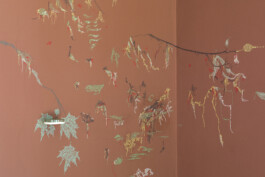
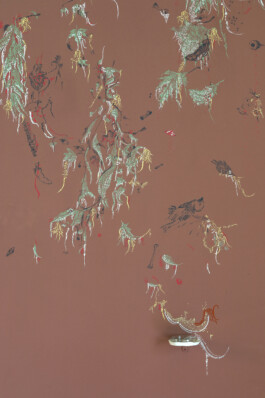
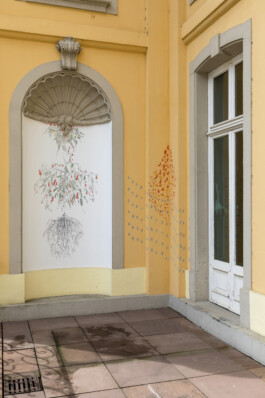
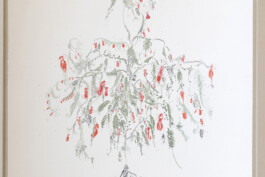
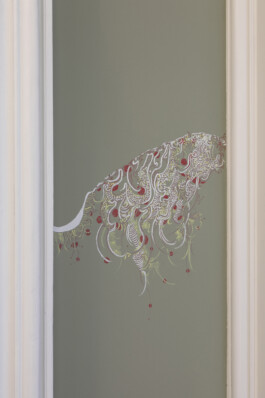
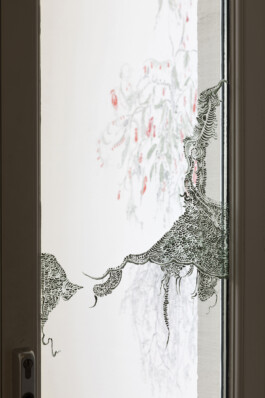
Eingefleischte Wege, 2023–2025; Photo: Werner Hannappel
Eingefleischte Wege, 2023–2025; Photo: Werner Hannappel
Eingefleischte Wege, 2023–2025; Photo: Werner Hannappel
Eingefleischte Wege, 2023–2025; Photo: Werner Hannappel
Eingefleischte Wege, 2023–2025; Photo: Werner Hannappel
Eingefleischte Wege, 2023–2025; Photo: Werner Hannappel
Eingefleischte Wege, 2023–2025; Photo: Werner Hannappel
Eingefleischte Wege, 2023–2025; Photo: Werner Hannappel
Over a period of three years, Gabriela Oberkofler, a member of the Morsbroich workshop, developed a permanent, expansive mural: starting from the Rococo stucco ceiling of the former ladies’ salon, her work gradually overgrows the wall, bringing plants, animals, and humans into relation with one another. Outside, on the back of the same wall, a delicate web of lines spreads out in a niche, reaching down to the roots. Finally, the two parts, inside and outside, the world above and below the earth, are connected by ornamental tendrils and a curtain of flowers and water droplets—the elixir without which coexistence on earth would not be possible.
During the Morsbroich Castle era in the 18th and 19th centuries, humans clearly dominated the cultivated flora and domesticated or hunted animals in the park: a one-sided dominance that later led to devastating effects, to injuries that, on closer inspection, are also evident in the ladies' salon.
Gabriela is preoccupied with the question of how the creatures of this earth can get along with each other in the future, how peaceful, sustainable coexistence is possible. She is concerned with leaving behind the “ingrained ways,” the well-trodden paths of the Anthropocene, which have recklessly and deeply cut into the substance of nature. The artist advocates a different approach to resources, to the (female) body, to nature, to plants, and to animals.
It is striking that when humans appear in this multi-part work, they are only shown in fragments, such as severed fingers, eyeballs, or organs on the inside of the wall—possible references to the (self-)destructive nature of humans. Instead of a human figure, such as a goddess of hunting or fertility, Gabriela places a plant structure at the center of the sculpture niche outside. The plants connect the sky, the growth zone, and the underworld of the roots. Their co-players are insects and birds. And even if this game may be deadly, as in the case of the carnivorous plant, and even if the transition between life and death is fundamentally fluid, it is nevertheless cyclical. We know that if we just hold back, it is possible to find a balance.
Erdenkugel (für Morsbroich), 2025
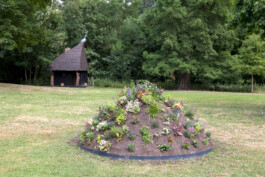
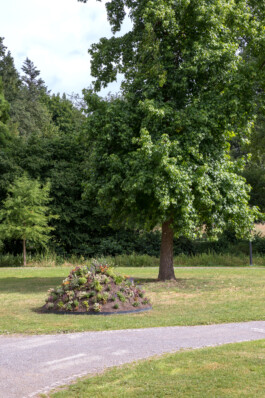
Erdenkugel (für Morsbroich), 2025; Photo: Werner Hannappel
Erdenkugel (für Morsbroich), 2025; Photo: Werner Hannappel
In the summer of 2025, Gabriela Oberkofler’s Erdenkugel (Earth Globe) was installed in the sculpture park of Museum Morsbroich with the support of volunteers. To the left behind the main building, her work has been created using living plants, a kind of slow gardening art project. A mound of earth rises up on the lawn, on which the artist has planted a sustainably growing mixed bed – a colorful mixture of edible wild herbs, which Gabriela has been collecting in a large seed archive since 2017.
The background to this is her research project Api étoilé – a growing archive named after an apple variety that was already cultivated by the ancient Romans. She has collected seeds from over 500 old varieties from various regions around the world, archived them, and drawn them. Plants from all parts of the world now grow together on and in the symbolic (half) globe located in Morsbroich.
Here, they form a special community. Based on the principle of sustainable land use (permaculture), Gabriela’s plants support each other in their growth and in defending themselves against diseases, predators, and (climate) stress. They communicate with each other and develop common survival strategies.
All texts: Friedrich Emslander
zusammen wachsen, 2023



zusammen wachsen, 2023, Museum Morsbroich, Leverkusen; Photo: Werner Hannappel
zusammen wachsen, 2023, Museum Morsbroich, Leverkusen; Photo: Werner Hannappel
zusammen wachsen, 2023, Museum Morsbroich, Leverkusen; Photo: Werner Hannappel
When the Morsbroich Workshop was founded in 2022 to rethink the museum and redesign the Morsbroich ensemble, it was necessary to clarify how each member would approach their area of responsibility and how the workshop as a collective would tackle the challenge. Collaborations quickly formed within the workshop. It was clear that in this structure of individuals and fields of activity, tasks could not be solved alone, but rather through dialogue.
Gabriela Oberkofler captured the dynamics of the early phase of the workshop process with her moss work. She invited the artists of the workshop to bring moss from their hometowns or elsewhere. Gabriela placed two or three different types of moss in a jar, which has remained sealed ever since (!). Each jar functions as a self-contained ecosystem in which the moss absorbs water in a cycle, extracts nutrients from it, and releases the liquid again. The mosses grow in the jars, they mate and crossbreed. As in an experiment, new, previously unknown species emerge.
The growth of moss can thus be seen as a symbol of the work of the artist collective, a work of constant transformation, cooperation, and renewal. Gabriela compares the way moss communicates directly with its environment, absorbing and releasing water, to the work of a museum: “What moss does with water, the museum does with social issues. It absorbs them and releases them in transformed form in the form of exhibitions.”
For the presentation of the moss glasses in the former ladies' salon and garden room of Morsbroich Castle, Gabriela, in cooperation with Harald F. Müller (Werkstatt Morsbroich), has planned a colorful frame with a slightly shimmering shade of pink (“Chanel”) developed by him and coordinated with the Rococo decoration.